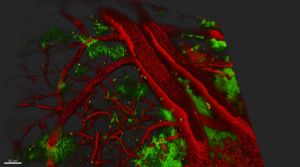In a recent discovery that may have life-changing implications for stroke patients worldwide, emerging research suggests that mild sensory stimulation such as touch can protect the brain if delivered within the first two hours following a stroke. Here, experimental stroke specialist PROF MARIO VALENTINOexplains how his research team is working towards uncovering the secrets of this ‘touch’.
As the world’s third leading cause of death, and the most common cause of severe disability, the impact of stroke as a disease continues to be globally devastating. In Malta alone, more than 10 per cent of the deaths in 2011 were a result of stroke.
Often occurring unexpectedly, a stroke can instantly rob a person of everything from their independence and dignity to their very personality. So significant is the social and economic impact created by stroke, that the need for research into its many facets has become elevated to a worldwide priority. Regardless of the type of stroke experienced – whether ischemic, in which clots stop blood flow to the brain, or the far less common haemorrhagic, where blood leaks into the brain tissue from ruptured vessels – scientists have long known the risk factors, signs, symptoms and causes of stroke. Yet, while promising results with hundreds of potential drugs have been achieved in animal stroke models, all PHASE III trials conducted to-date have failed to live up to their promise.
Dr Jasmine Vella and Dr Christian Zammit, who form a dedicated stroke research team of scientists in the Laboratory for the Study of Neurological Disorders at the University of Malta led by Prof Mario Valentino, now seek a new solution, by using highly sophisticated technology to focus upon the crux of the issue: what protects the brain in such circumstances.
Prof Valentino explains the process. “Using advanced laser imaging microscopic techniques, the team examines the sequence of events that unfolds in the rodent brain following a stroke in real-time, to establish how sensory stimulation might then help to protect the brain from the ensuing consequences. To do this, we use powerful lasers and very sensitive detectors coupled with special lenses, which allows us to capture the very fast events that unravel when a blood clot interrupts the blood supply in the brain, while observing what happens to the neighbouring blood vessels, nerve cells and support cells, and the limb movements of the rodent throughout.”
The team is now painstakingly correlating the data obtained during this brain imaging with the rodent’s movement and trajectory. A motion-tracking device fitted under a sophisticated microscope allows behavioural readouts during high-precision tactile stimulation while the rodent is positioned in an air-lifted carbon fibre stage. Once the stage starts to float, the rodent moves effortlessly on its paws. “A stroke often causes altered gait movements in humans and so this technique will immediately detect any abnormal behavioural and locomotor readouts with high precision,” Prof Valentino continues.
Likewise, if the protection is proven to be the direct cause of new blood vessels resulting from the tactile-generated electrical activity, then the team may then explore ways in which to introduce factors that could help redirect blood vessels or enhance neovascularisation to the affected area.
“This accidental discovery could be potentially life-changing for stroke patients,” Prof Valentino elaborates. “The key is to figure out the mechanism involved in how sensory stimulation affects stroke patients, and then establish the best ways to activate that mechanism. Perhaps touching a stroke victim’s hands and face could have a similar beneficial effect, but this is what this latest research study hopes to define.”
In another recent breakthrough published in Nature Communications in collaboration with scientists from the University Peninsula Schools of Medicine and Dentistry in the UK, the team previously identified a new drug, QNZ-46, that could protect the rodent brain following a stroke.
“This project was about neuroprotective agents – to create a drug that will substantially block or reduce the injury, and so benefit a wider selection of patients through thrombolysis at a stroke care unit,” explains Prof Valentino. “The study identified the source of release of the neurotransmitter glutamate, which is the cause of the damage produced in stroke. We established that, during a stroke, glutamate gets trapped beneath the myelin sheath where it could over-activate receptors leading to massive cell death. This led to the discovery that QNZ-46 prevents damage to the myelin sheath and nerve fibres, and protects them from the toxic effects of the glutamate. This is potentially the first ever non-toxic drug that could prevent cell death during a stroke by blocking a very specific receptor type, and the results from this collaborative research could well become a precursor to pharmaceutical trials. We have now further extended these studies to include other collaborators from other universities.”
While research for these studies has been supported through generous funding by the Alfred Mizzi Foundation through RIDT, globally-significant discoveries such as these would not be possible without funding from local entities, as Prof Valentino concludes.
“The funding of such projects is so important, as this money is life-changing for people in such a predicament. Malta is a small country with limited resources – including human resources – and yet our work is regularly impactful on a global scale. Malta can still prove itself internationally, especially in terms of research towards technology, environment and health. In fact, I believe health research should be given priority, since it changes everything – our lifestyle, our quality of life, our longevity. And yet government funding for research is still lacking – it’s only thanks to private companies and RIDT, who realise the global potential of our work, that these projects can continue to improve, progress, and hopefully change the lives of people not just in Malta, but all over the world.”
Help us fund more projects like this, as well as research in all the faculties, by donating to RIDT. Click here for more information on how to donate.


